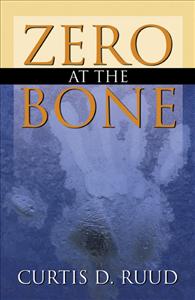|
Zero at the Bone

|
by:
ISBN:
0-7414-2132-1
©2004
Price:
$20.95
Book Size:
5.5'' x 8.5''
, 458 pages
Category/Subject:
FICTION / Action & Adventure
Wondrous tall tales, truth, and subtle humor unite in author Curtis D. Ruud’s fast-stepping, dangerous, and mythological adventures of a young boy
|
|
|
Abstract:
Zero at the Bone is a tragicomical adventure of a young boy who leaves his drunk father and home after a night of violence and terror. With his mother and sister as guides, the boy takes a Dantean journey on Christmas day down a hill, through town, and up to his grandmother's home, where he finds love and safety, albeit temporary. The walk forces upon the boy an awakening of his family's diverse past and that it is not the destination that is all-important in his life, but rather the journey through life, which can bring wisdom and love.
Click Here for a SNEAK
PEEK of this book.
|
Customer Reviews
     "Fictional Sioux Falls" in ETC.
,
07/24/2006
"Fictional Sioux Falls" in ETC.
,
07/24/2006
|
|
Reviewer:
Ron Robinson
|
|
Place is very important in American fiction, but the places that have entered the collective memory have often as not been in large part the creation of writers, sometimes so strongly portrayed as to convince us of the reality of, say, Mark Twain's Mississippi River or William Faulkner's Yoknapatawpha County. The real place is a moving target, constantly in a stage of Becoming, in the the Platonic sense, while the fictional place is the the realm of Being.
All of which brings us to Zero at the Bone, a novel by Curtis D. Ruud, a retired professor of English at Augustana College, now residing in Florida. Ruud grew up in the Sioux Falls of the 1930s, and the Sioux Falls of the gritty decade is the setting for the fictional treatment of a boy's struggle to escape from poverty and from a tyrannical father. The boy, who narrates the tale, owes much to Huckleberry Finn, whose adventures he has avidly read. The father, whose nickname is Shorty, makes Huck's Pap look like a piker by comparison; he is a drunk and a lout, whose idea of being clever is to cheat the coalman out of a few extra chunks and whose principal recreation, aside from drinking, is punching out members of his family. Think of the father in Frank McCourt's Angelas's Ashes, but without the charm.
The city, thinly disguised as Quarry Town, is in many ways the real star of the book, taking on allegorical significance as the boy, his mother, and his sister wend their way from their wretched hovel on the wrong side of the river to refuge up the hill on the other side. In the middle of this fictional microcosm is a den of iniquity called "The Bucket of Blood," a dive built on an island between the opposing banks of the Serpent River (read Big Sioux), occupying the same position as the Inferno does in Dante's Satan-centric Divine Comedy. The most vivid prose is reserved for descriptions of this wretched palace of sin as the boy is dragged into it by his father. As both Dante and Milton demonstrated, evil has a fascination lacking in heavenly locales, and The Bucket of Blood and its denizens, replete with sights, noises, and smells, are likely to be etched in the reader's memory as strongly as they are in the boy's.
Many Sioux Falls landmarks may be discerned behind the gauze curtain of allegory--the penitentiary, the old mill, the old courthouse, and the buildings and cobblestones of pink quartzite (called red granite in the book) which dominated the early city. Oldtimers will be able to recognize some legendary characters, as well, such as Highhips (read "Highpockets"), a woman whose looming presence was a commonplace sight during that era. Everything about the town seems broken and slightly shabby, as befits the city of that time between early prosperity and World War II revival, and the story takes place on a frigid winter's day, never a good time to see the town's best side.
Apart from the fascinating milieu, the story is an engaging one, and the narrator's voice is colorful and distinctive. The peripety and denouement at the end of the novel is more discursive than dramatic, but then so too is Huck's wrestling with his conscience in the central scene of Mark Twain's masterpiece. Like Huck, the protagonist of Zero at the Bone is learning what it means to be good and is growing into an understanding of the complexities of life and the principles and compromises required of it. It is in those lessons that the larger truths emerge.
|
Was this review helpful?
|
Have you read this book? Write a review and share your thoughts with other customers!
|